Analyzing the Difficulties of Banning Tobacco Advertising Globally
VerifiedAdded on 2022/09/29
|10
|2626
|75
Essay
AI Summary
This essay explores the complexities of banning tobacco advertising, particularly in developing nations. It begins with an introduction discussing the history of tobacco advertising regulations and the anticipated rise in tobacco consumption in developing countries, highlighting the ineffectiveness of current policies. The discussion section delves into the controversies surrounding the impact of tobacco advertisements on consumption rates, examining arguments from both pro and anti-ban perspectives. It also explores the reasons behind higher tobacco consumption in developing countries compared to developed nations, including factors like low literacy rates and the addictive nature of tobacco. The essay further analyzes the failures of rehabilitation centers and the impact of high taxes on tobacco users in developing countries. The conclusion synthesizes the arguments, suggesting that while raising prices is more effective in reducing consumption, advertising bans also play a significant role. It also emphasizes the need for a comprehensive approach involving regulations on advertising, sales, and taxation to effectively control tobacco consumption, especially in the developing world. The essay is based on a comprehensive review of the relevant literature, and supported by at least 8 references from peer reviewed journals or other credible sources.
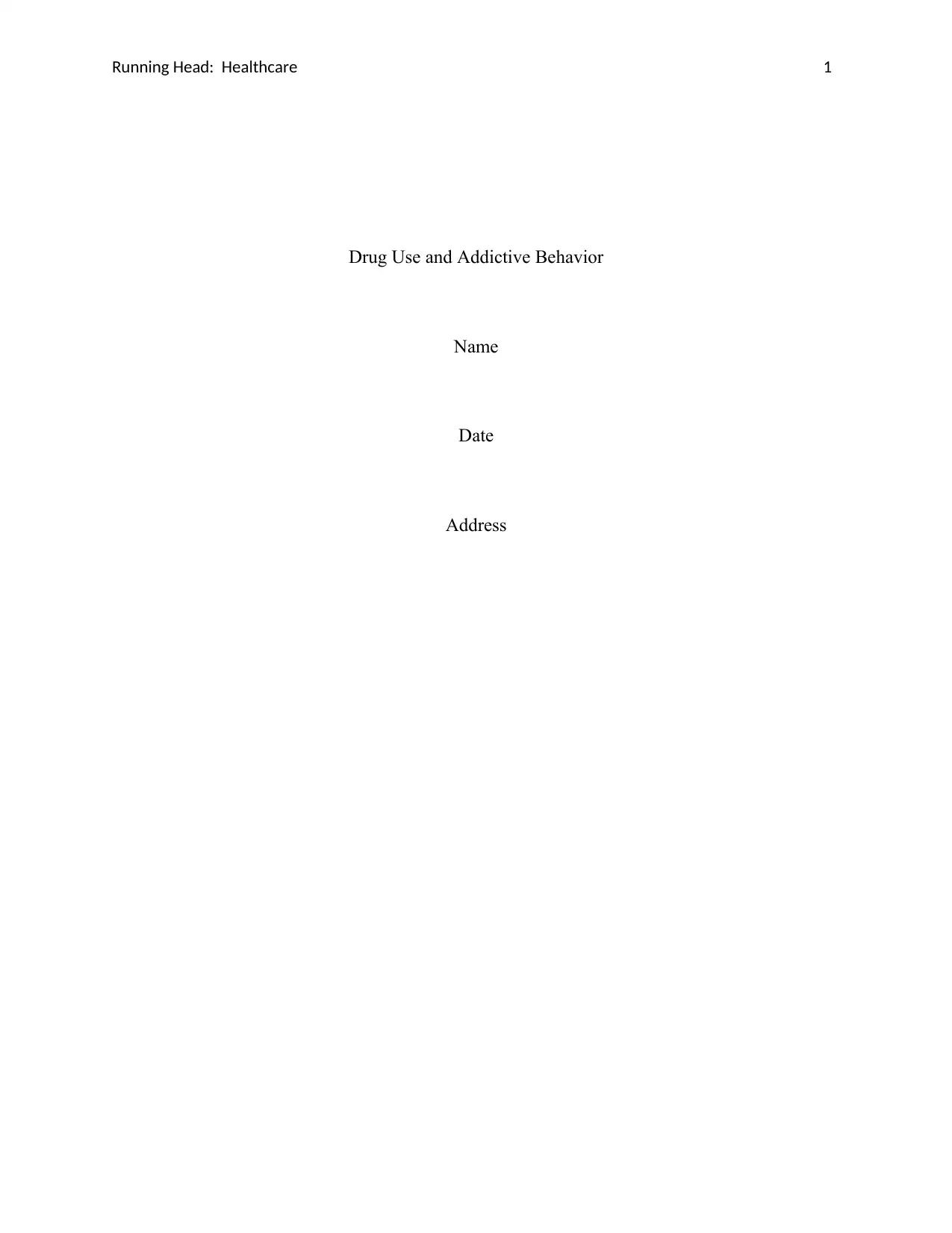
Running Head: Healthcare 1
Drug Use and Addictive Behavior
Name
Date
Address
Drug Use and Addictive Behavior
Name
Date
Address
Paraphrase This Document
Need a fresh take? Get an instant paraphrase of this document with our AI Paraphraser
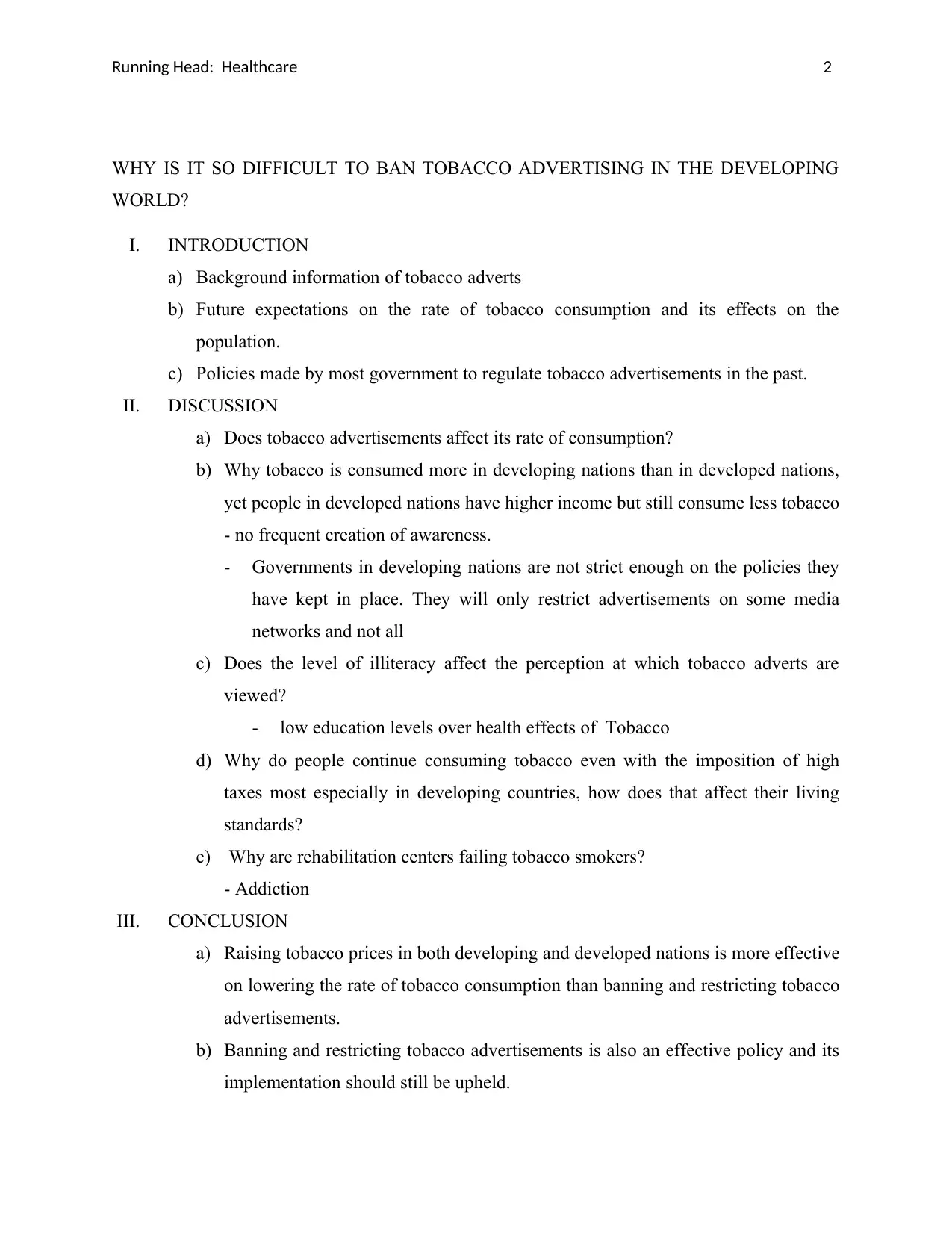
Running Head: Healthcare 2
WHY IS IT SO DIFFICULT TO BAN TOBACCO ADVERTISING IN THE DEVELOPING
WORLD?
I. INTRODUCTION
a) Background information of tobacco adverts
b) Future expectations on the rate of tobacco consumption and its effects on the
population.
c) Policies made by most government to regulate tobacco advertisements in the past.
II. DISCUSSION
a) Does tobacco advertisements affect its rate of consumption?
b) Why tobacco is consumed more in developing nations than in developed nations,
yet people in developed nations have higher income but still consume less tobacco
- no frequent creation of awareness.
- Governments in developing nations are not strict enough on the policies they
have kept in place. They will only restrict advertisements on some media
networks and not all
c) Does the level of illiteracy affect the perception at which tobacco adverts are
viewed?
- low education levels over health effects of Tobacco
d) Why do people continue consuming tobacco even with the imposition of high
taxes most especially in developing countries, how does that affect their living
standards?
e) Why are rehabilitation centers failing tobacco smokers?
- Addiction
III. CONCLUSION
a) Raising tobacco prices in both developing and developed nations is more effective
on lowering the rate of tobacco consumption than banning and restricting tobacco
advertisements.
b) Banning and restricting tobacco advertisements is also an effective policy and its
implementation should still be upheld.
WHY IS IT SO DIFFICULT TO BAN TOBACCO ADVERTISING IN THE DEVELOPING
WORLD?
I. INTRODUCTION
a) Background information of tobacco adverts
b) Future expectations on the rate of tobacco consumption and its effects on the
population.
c) Policies made by most government to regulate tobacco advertisements in the past.
II. DISCUSSION
a) Does tobacco advertisements affect its rate of consumption?
b) Why tobacco is consumed more in developing nations than in developed nations,
yet people in developed nations have higher income but still consume less tobacco
- no frequent creation of awareness.
- Governments in developing nations are not strict enough on the policies they
have kept in place. They will only restrict advertisements on some media
networks and not all
c) Does the level of illiteracy affect the perception at which tobacco adverts are
viewed?
- low education levels over health effects of Tobacco
d) Why do people continue consuming tobacco even with the imposition of high
taxes most especially in developing countries, how does that affect their living
standards?
e) Why are rehabilitation centers failing tobacco smokers?
- Addiction
III. CONCLUSION
a) Raising tobacco prices in both developing and developed nations is more effective
on lowering the rate of tobacco consumption than banning and restricting tobacco
advertisements.
b) Banning and restricting tobacco advertisements is also an effective policy and its
implementation should still be upheld.
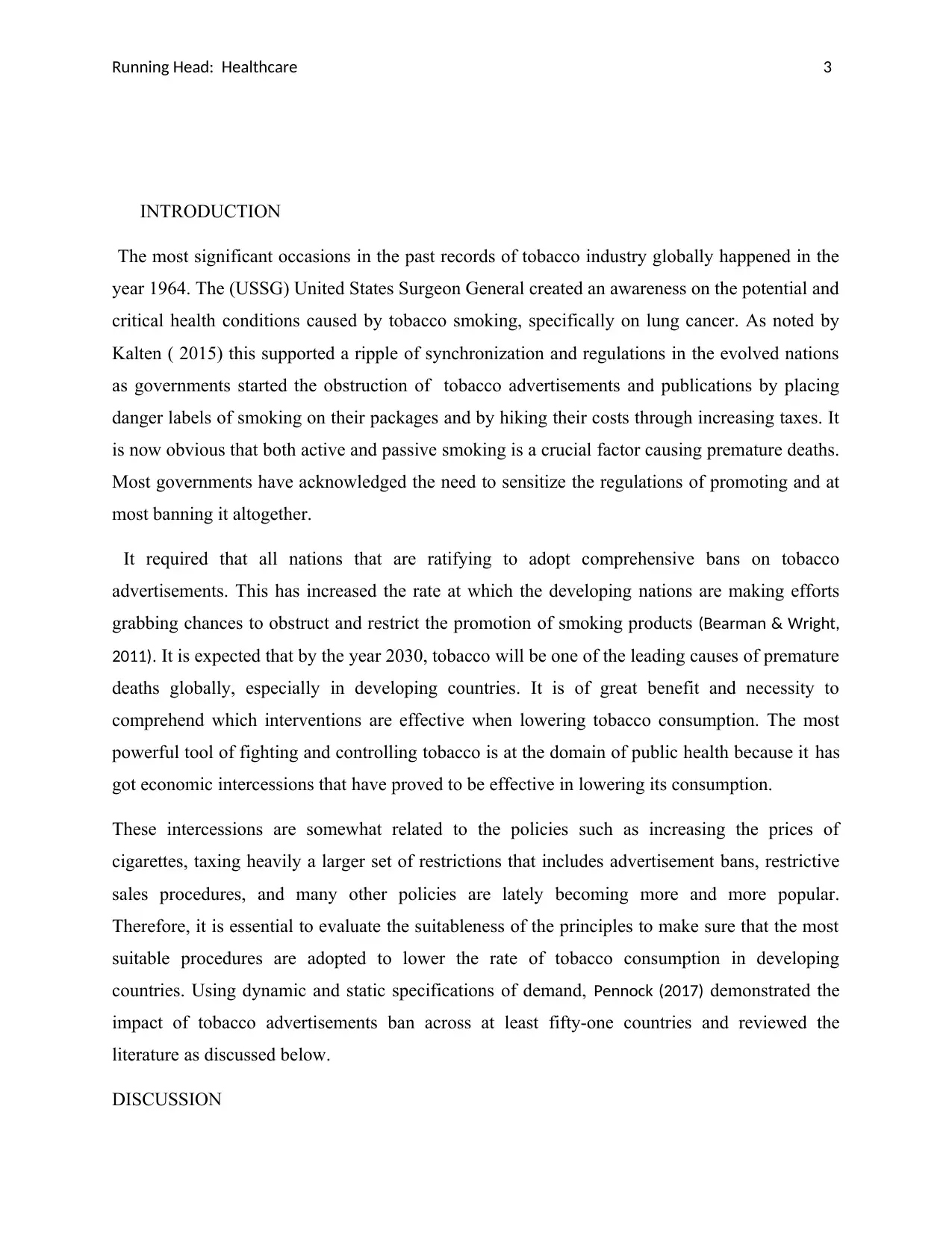
Running Head: Healthcare 3
INTRODUCTION
The most significant occasions in the past records of tobacco industry globally happened in the
year 1964. The (USSG) United States Surgeon General created an awareness on the potential and
critical health conditions caused by tobacco smoking, specifically on lung cancer. As noted by
Kalten ( 2015) this supported a ripple of synchronization and regulations in the evolved nations
as governments started the obstruction of tobacco advertisements and publications by placing
danger labels of smoking on their packages and by hiking their costs through increasing taxes. It
is now obvious that both active and passive smoking is a crucial factor causing premature deaths.
Most governments have acknowledged the need to sensitize the regulations of promoting and at
most banning it altogether.
It required that all nations that are ratifying to adopt comprehensive bans on tobacco
advertisements. This has increased the rate at which the developing nations are making efforts
grabbing chances to obstruct and restrict the promotion of smoking products (Bearman & Wright,
2011). It is expected that by the year 2030, tobacco will be one of the leading causes of premature
deaths globally, especially in developing countries. It is of great benefit and necessity to
comprehend which interventions are effective when lowering tobacco consumption. The most
powerful tool of fighting and controlling tobacco is at the domain of public health because it has
got economic intercessions that have proved to be effective in lowering its consumption.
These intercessions are somewhat related to the policies such as increasing the prices of
cigarettes, taxing heavily a larger set of restrictions that includes advertisement bans, restrictive
sales procedures, and many other policies are lately becoming more and more popular.
Therefore, it is essential to evaluate the suitableness of the principles to make sure that the most
suitable procedures are adopted to lower the rate of tobacco consumption in developing
countries. Using dynamic and static specifications of demand, Pennock (2017) demonstrated the
impact of tobacco advertisements ban across at least fifty-one countries and reviewed the
literature as discussed below.
DISCUSSION
INTRODUCTION
The most significant occasions in the past records of tobacco industry globally happened in the
year 1964. The (USSG) United States Surgeon General created an awareness on the potential and
critical health conditions caused by tobacco smoking, specifically on lung cancer. As noted by
Kalten ( 2015) this supported a ripple of synchronization and regulations in the evolved nations
as governments started the obstruction of tobacco advertisements and publications by placing
danger labels of smoking on their packages and by hiking their costs through increasing taxes. It
is now obvious that both active and passive smoking is a crucial factor causing premature deaths.
Most governments have acknowledged the need to sensitize the regulations of promoting and at
most banning it altogether.
It required that all nations that are ratifying to adopt comprehensive bans on tobacco
advertisements. This has increased the rate at which the developing nations are making efforts
grabbing chances to obstruct and restrict the promotion of smoking products (Bearman & Wright,
2011). It is expected that by the year 2030, tobacco will be one of the leading causes of premature
deaths globally, especially in developing countries. It is of great benefit and necessity to
comprehend which interventions are effective when lowering tobacco consumption. The most
powerful tool of fighting and controlling tobacco is at the domain of public health because it has
got economic intercessions that have proved to be effective in lowering its consumption.
These intercessions are somewhat related to the policies such as increasing the prices of
cigarettes, taxing heavily a larger set of restrictions that includes advertisement bans, restrictive
sales procedures, and many other policies are lately becoming more and more popular.
Therefore, it is essential to evaluate the suitableness of the principles to make sure that the most
suitable procedures are adopted to lower the rate of tobacco consumption in developing
countries. Using dynamic and static specifications of demand, Pennock (2017) demonstrated the
impact of tobacco advertisements ban across at least fifty-one countries and reviewed the
literature as discussed below.
DISCUSSION
⊘ This is a preview!⊘
Do you want full access?
Subscribe today to unlock all pages.

Trusted by 1+ million students worldwide
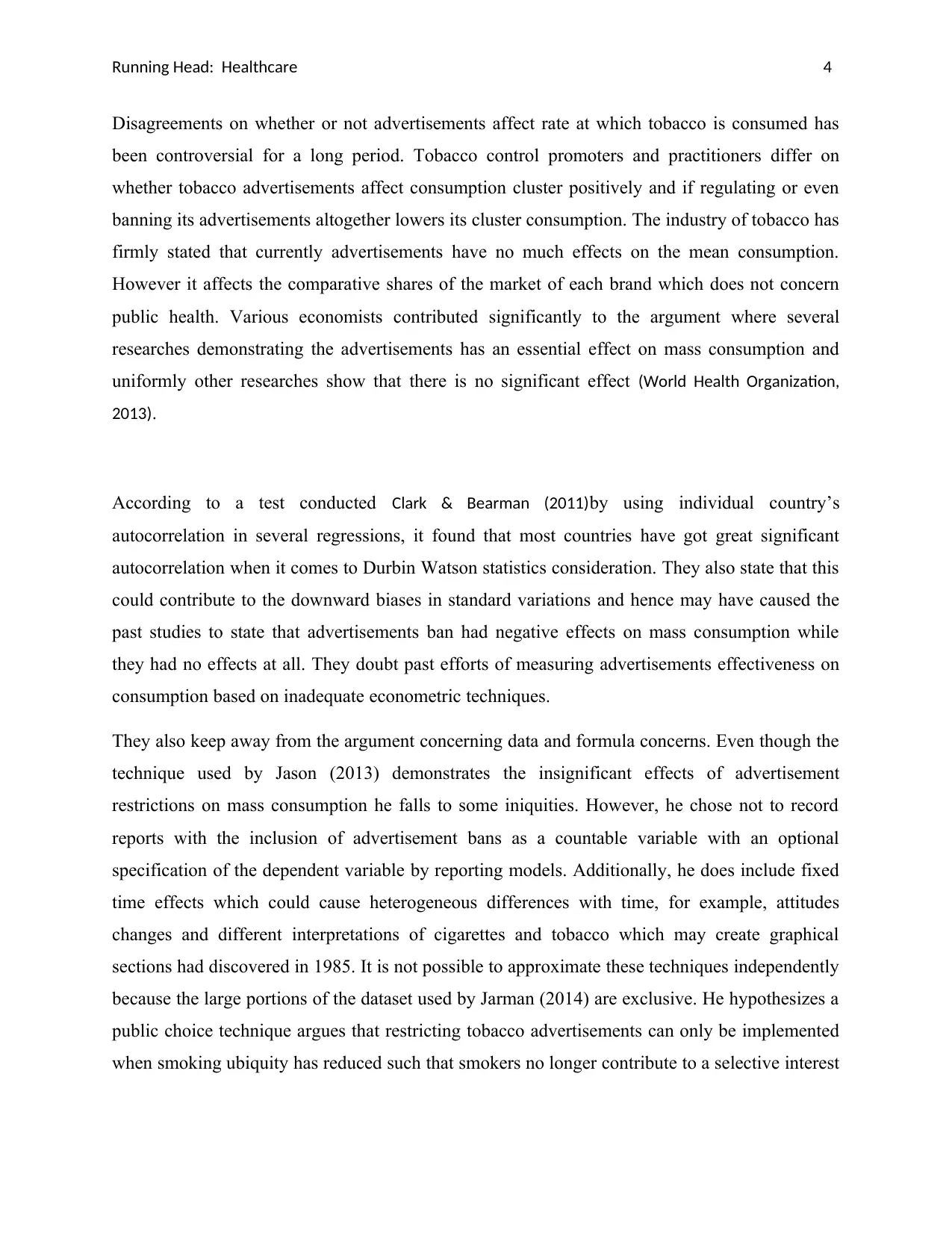
Running Head: Healthcare 4
Disagreements on whether or not advertisements affect rate at which tobacco is consumed has
been controversial for a long period. Tobacco control promoters and practitioners differ on
whether tobacco advertisements affect consumption cluster positively and if regulating or even
banning its advertisements altogether lowers its cluster consumption. The industry of tobacco has
firmly stated that currently advertisements have no much effects on the mean consumption.
However it affects the comparative shares of the market of each brand which does not concern
public health. Various economists contributed significantly to the argument where several
researches demonstrating the advertisements has an essential effect on mass consumption and
uniformly other researches show that there is no significant effect (World Health Organization,
2013).
According to a test conducted Clark & Bearman (2011)by using individual country’s
autocorrelation in several regressions, it found that most countries have got great significant
autocorrelation when it comes to Durbin Watson statistics consideration. They also state that this
could contribute to the downward biases in standard variations and hence may have caused the
past studies to state that advertisements ban had negative effects on mass consumption while
they had no effects at all. They doubt past efforts of measuring advertisements effectiveness on
consumption based on inadequate econometric techniques.
They also keep away from the argument concerning data and formula concerns. Even though the
technique used by Jason (2013) demonstrates the insignificant effects of advertisement
restrictions on mass consumption he falls to some iniquities. However, he chose not to record
reports with the inclusion of advertisement bans as a countable variable with an optional
specification of the dependent variable by reporting models. Additionally, he does include fixed
time effects which could cause heterogeneous differences with time, for example, attitudes
changes and different interpretations of cigarettes and tobacco which may create graphical
sections had discovered in 1985. It is not possible to approximate these techniques independently
because the large portions of the dataset used by Jarman (2014) are exclusive. He hypothesizes a
public choice technique argues that restricting tobacco advertisements can only be implemented
when smoking ubiquity has reduced such that smokers no longer contribute to a selective interest
Disagreements on whether or not advertisements affect rate at which tobacco is consumed has
been controversial for a long period. Tobacco control promoters and practitioners differ on
whether tobacco advertisements affect consumption cluster positively and if regulating or even
banning its advertisements altogether lowers its cluster consumption. The industry of tobacco has
firmly stated that currently advertisements have no much effects on the mean consumption.
However it affects the comparative shares of the market of each brand which does not concern
public health. Various economists contributed significantly to the argument where several
researches demonstrating the advertisements has an essential effect on mass consumption and
uniformly other researches show that there is no significant effect (World Health Organization,
2013).
According to a test conducted Clark & Bearman (2011)by using individual country’s
autocorrelation in several regressions, it found that most countries have got great significant
autocorrelation when it comes to Durbin Watson statistics consideration. They also state that this
could contribute to the downward biases in standard variations and hence may have caused the
past studies to state that advertisements ban had negative effects on mass consumption while
they had no effects at all. They doubt past efforts of measuring advertisements effectiveness on
consumption based on inadequate econometric techniques.
They also keep away from the argument concerning data and formula concerns. Even though the
technique used by Jason (2013) demonstrates the insignificant effects of advertisement
restrictions on mass consumption he falls to some iniquities. However, he chose not to record
reports with the inclusion of advertisement bans as a countable variable with an optional
specification of the dependent variable by reporting models. Additionally, he does include fixed
time effects which could cause heterogeneous differences with time, for example, attitudes
changes and different interpretations of cigarettes and tobacco which may create graphical
sections had discovered in 1985. It is not possible to approximate these techniques independently
because the large portions of the dataset used by Jarman (2014) are exclusive. He hypothesizes a
public choice technique argues that restricting tobacco advertisements can only be implemented
when smoking ubiquity has reduced such that smokers no longer contribute to a selective interest
Paraphrase This Document
Need a fresh take? Get an instant paraphrase of this document with our AI Paraphraser
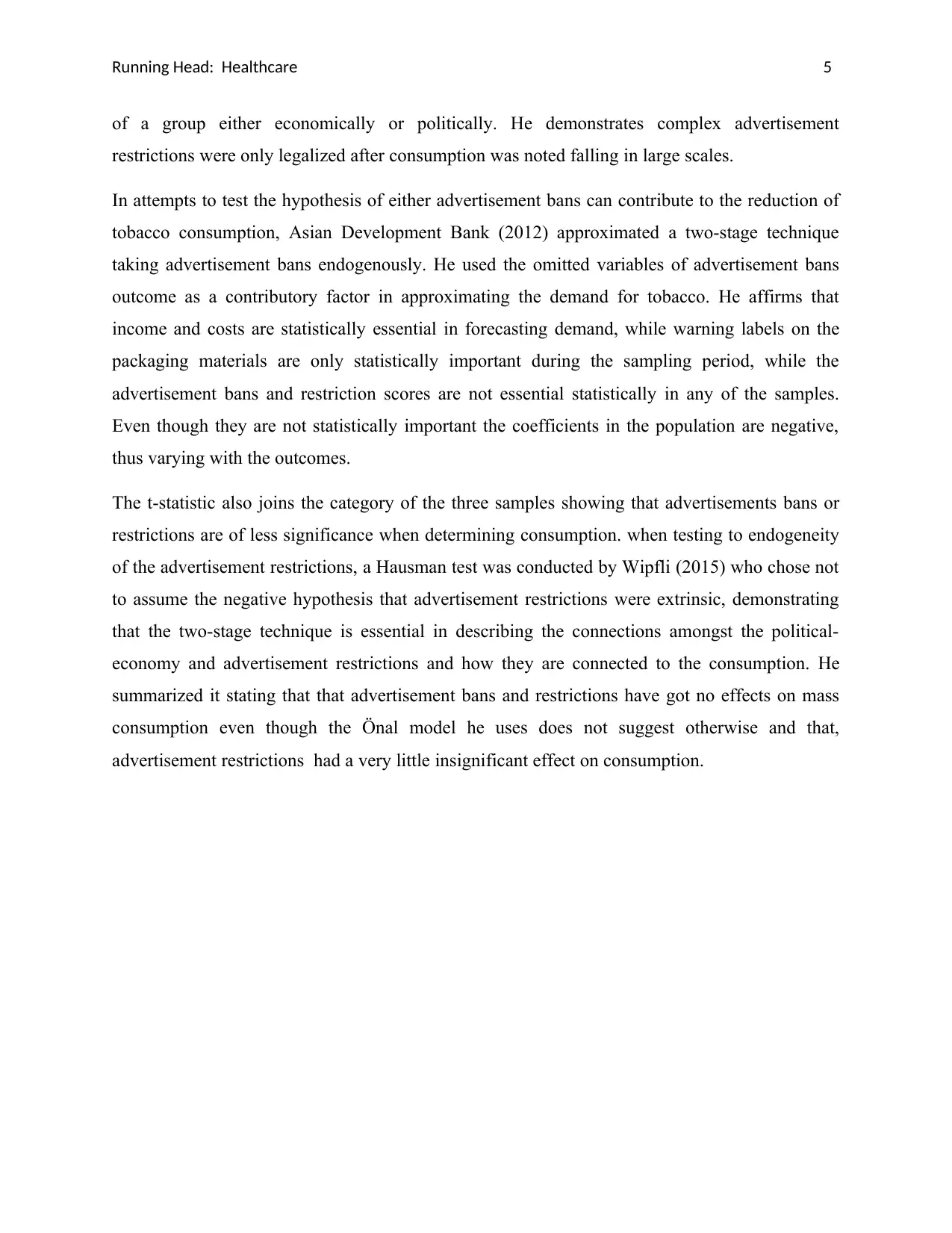
Running Head: Healthcare 5
of a group either economically or politically. He demonstrates complex advertisement
restrictions were only legalized after consumption was noted falling in large scales.
In attempts to test the hypothesis of either advertisement bans can contribute to the reduction of
tobacco consumption, Asian Development Bank (2012) approximated a two-stage technique
taking advertisement bans endogenously. He used the omitted variables of advertisement bans
outcome as a contributory factor in approximating the demand for tobacco. He affirms that
income and costs are statistically essential in forecasting demand, while warning labels on the
packaging materials are only statistically important during the sampling period, while the
advertisement bans and restriction scores are not essential statistically in any of the samples.
Even though they are not statistically important the coefficients in the population are negative,
thus varying with the outcomes.
The t-statistic also joins the category of the three samples showing that advertisements bans or
restrictions are of less significance when determining consumption. when testing to endogeneity
of the advertisement restrictions, a Hausman test was conducted by Wipfli (2015) who chose not
to assume the negative hypothesis that advertisement restrictions were extrinsic, demonstrating
that the two-stage technique is essential in describing the connections amongst the political-
economy and advertisement restrictions and how they are connected to the consumption. He
summarized it stating that that advertisement bans and restrictions have got no effects on mass
consumption even though the Önal model he uses does not suggest otherwise and that,
advertisement restrictions had a very little insignificant effect on consumption.
of a group either economically or politically. He demonstrates complex advertisement
restrictions were only legalized after consumption was noted falling in large scales.
In attempts to test the hypothesis of either advertisement bans can contribute to the reduction of
tobacco consumption, Asian Development Bank (2012) approximated a two-stage technique
taking advertisement bans endogenously. He used the omitted variables of advertisement bans
outcome as a contributory factor in approximating the demand for tobacco. He affirms that
income and costs are statistically essential in forecasting demand, while warning labels on the
packaging materials are only statistically important during the sampling period, while the
advertisement bans and restriction scores are not essential statistically in any of the samples.
Even though they are not statistically important the coefficients in the population are negative,
thus varying with the outcomes.
The t-statistic also joins the category of the three samples showing that advertisements bans or
restrictions are of less significance when determining consumption. when testing to endogeneity
of the advertisement restrictions, a Hausman test was conducted by Wipfli (2015) who chose not
to assume the negative hypothesis that advertisement restrictions were extrinsic, demonstrating
that the two-stage technique is essential in describing the connections amongst the political-
economy and advertisement restrictions and how they are connected to the consumption. He
summarized it stating that that advertisement bans and restrictions have got no effects on mass
consumption even though the Önal model he uses does not suggest otherwise and that,
advertisement restrictions had a very little insignificant effect on consumption.
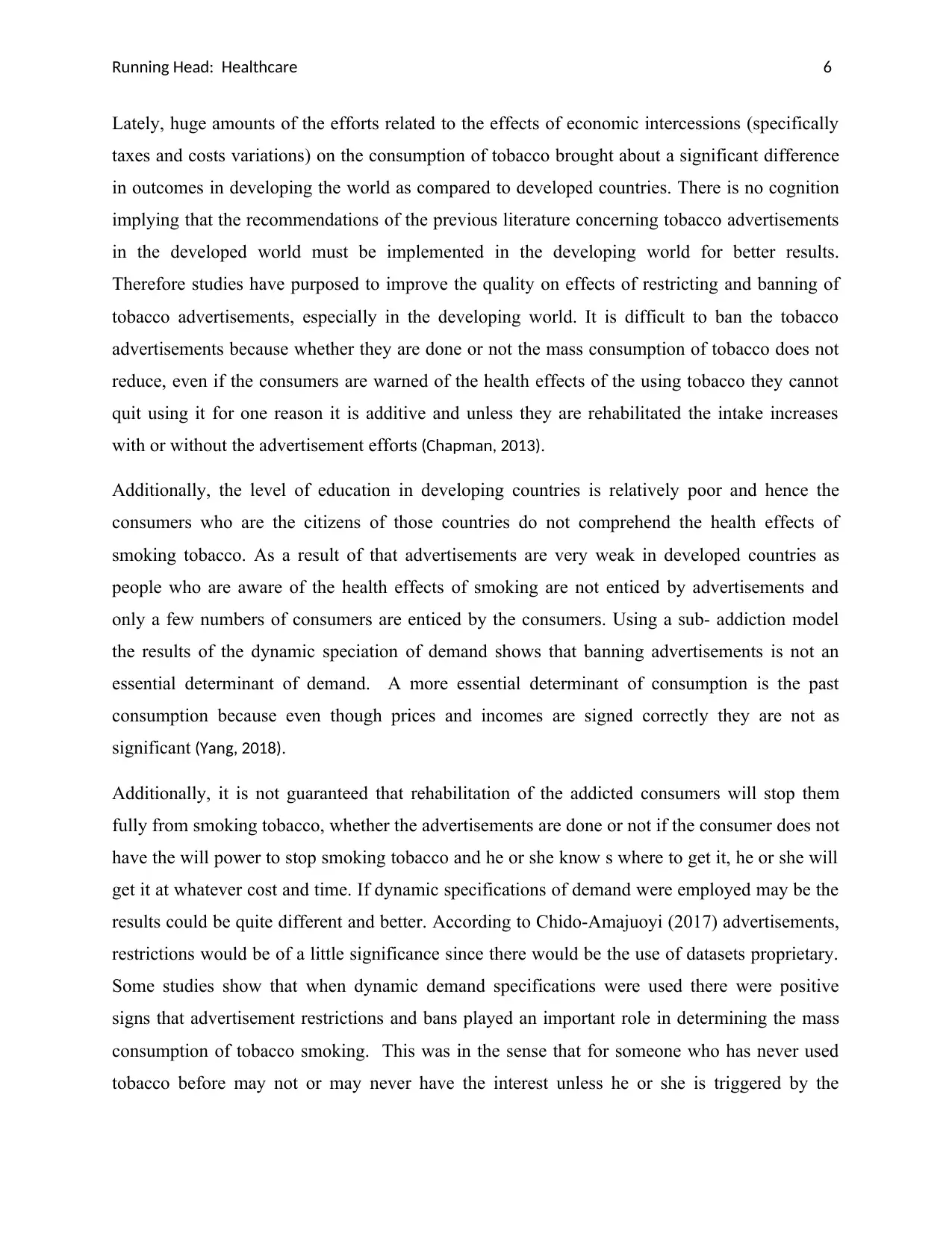
Running Head: Healthcare 6
Lately, huge amounts of the efforts related to the effects of economic intercessions (specifically
taxes and costs variations) on the consumption of tobacco brought about a significant difference
in outcomes in developing the world as compared to developed countries. There is no cognition
implying that the recommendations of the previous literature concerning tobacco advertisements
in the developed world must be implemented in the developing world for better results.
Therefore studies have purposed to improve the quality on effects of restricting and banning of
tobacco advertisements, especially in the developing world. It is difficult to ban the tobacco
advertisements because whether they are done or not the mass consumption of tobacco does not
reduce, even if the consumers are warned of the health effects of the using tobacco they cannot
quit using it for one reason it is additive and unless they are rehabilitated the intake increases
with or without the advertisement efforts (Chapman, 2013).
Additionally, the level of education in developing countries is relatively poor and hence the
consumers who are the citizens of those countries do not comprehend the health effects of
smoking tobacco. As a result of that advertisements are very weak in developed countries as
people who are aware of the health effects of smoking are not enticed by advertisements and
only a few numbers of consumers are enticed by the consumers. Using a sub- addiction model
the results of the dynamic speciation of demand shows that banning advertisements is not an
essential determinant of demand. A more essential determinant of consumption is the past
consumption because even though prices and incomes are signed correctly they are not as
significant (Yang, 2018).
Additionally, it is not guaranteed that rehabilitation of the addicted consumers will stop them
fully from smoking tobacco, whether the advertisements are done or not if the consumer does not
have the will power to stop smoking tobacco and he or she know s where to get it, he or she will
get it at whatever cost and time. If dynamic specifications of demand were employed may be the
results could be quite different and better. According to Chido-Amajuoyi (2017) advertisements,
restrictions would be of a little significance since there would be the use of datasets proprietary.
Some studies show that when dynamic demand specifications were used there were positive
signs that advertisement restrictions and bans played an important role in determining the mass
consumption of tobacco smoking. This was in the sense that for someone who has never used
tobacco before may not or may never have the interest unless he or she is triggered by the
Lately, huge amounts of the efforts related to the effects of economic intercessions (specifically
taxes and costs variations) on the consumption of tobacco brought about a significant difference
in outcomes in developing the world as compared to developed countries. There is no cognition
implying that the recommendations of the previous literature concerning tobacco advertisements
in the developed world must be implemented in the developing world for better results.
Therefore studies have purposed to improve the quality on effects of restricting and banning of
tobacco advertisements, especially in the developing world. It is difficult to ban the tobacco
advertisements because whether they are done or not the mass consumption of tobacco does not
reduce, even if the consumers are warned of the health effects of the using tobacco they cannot
quit using it for one reason it is additive and unless they are rehabilitated the intake increases
with or without the advertisement efforts (Chapman, 2013).
Additionally, the level of education in developing countries is relatively poor and hence the
consumers who are the citizens of those countries do not comprehend the health effects of
smoking tobacco. As a result of that advertisements are very weak in developed countries as
people who are aware of the health effects of smoking are not enticed by advertisements and
only a few numbers of consumers are enticed by the consumers. Using a sub- addiction model
the results of the dynamic speciation of demand shows that banning advertisements is not an
essential determinant of demand. A more essential determinant of consumption is the past
consumption because even though prices and incomes are signed correctly they are not as
significant (Yang, 2018).
Additionally, it is not guaranteed that rehabilitation of the addicted consumers will stop them
fully from smoking tobacco, whether the advertisements are done or not if the consumer does not
have the will power to stop smoking tobacco and he or she know s where to get it, he or she will
get it at whatever cost and time. If dynamic specifications of demand were employed may be the
results could be quite different and better. According to Chido-Amajuoyi (2017) advertisements,
restrictions would be of a little significance since there would be the use of datasets proprietary.
Some studies show that when dynamic demand specifications were used there were positive
signs that advertisement restrictions and bans played an important role in determining the mass
consumption of tobacco smoking. This was in the sense that for someone who has never used
tobacco before may not or may never have the interest unless he or she is triggered by the
⊘ This is a preview!⊘
Do you want full access?
Subscribe today to unlock all pages.

Trusted by 1+ million students worldwide
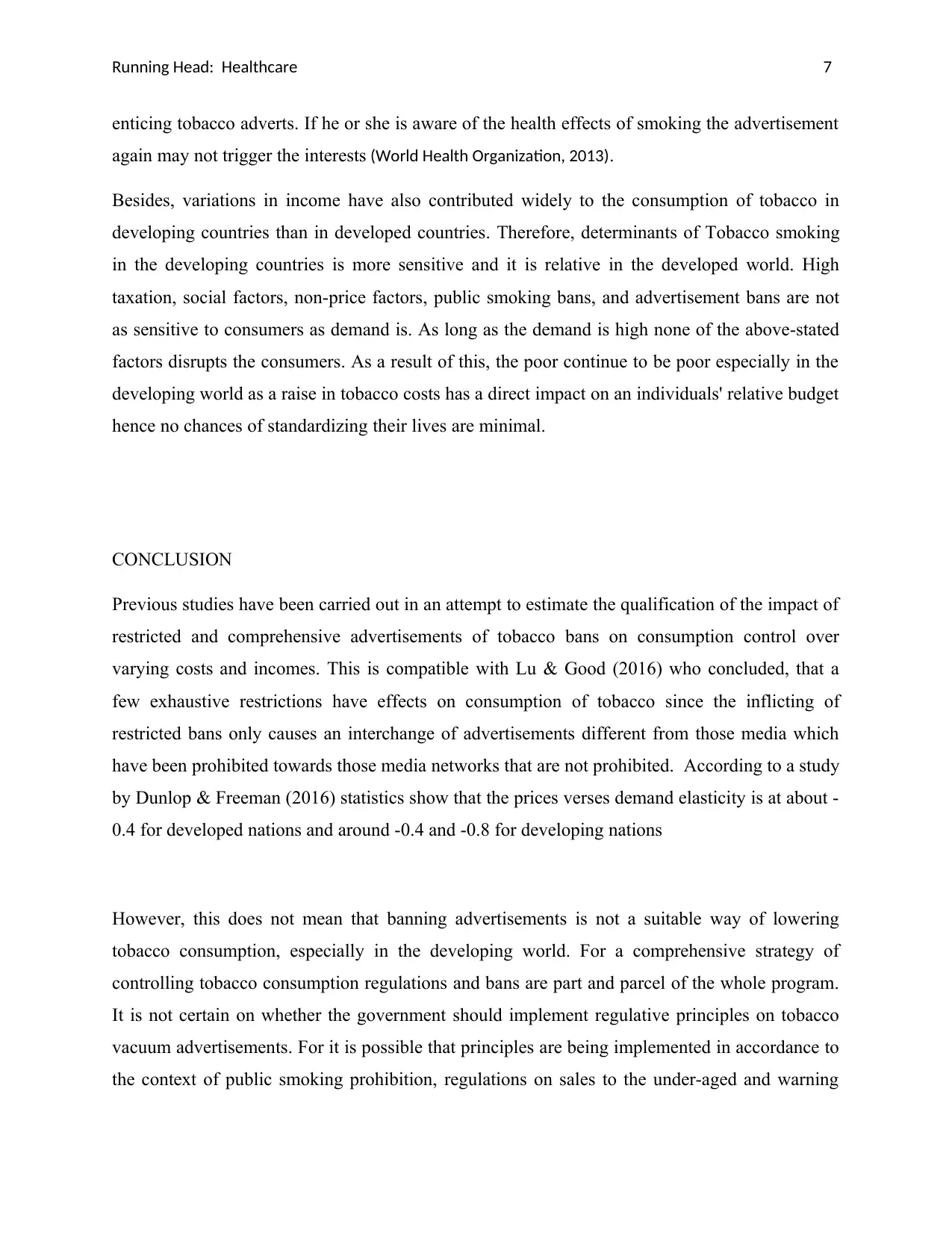
Running Head: Healthcare 7
enticing tobacco adverts. If he or she is aware of the health effects of smoking the advertisement
again may not trigger the interests (World Health Organization, 2013).
Besides, variations in income have also contributed widely to the consumption of tobacco in
developing countries than in developed countries. Therefore, determinants of Tobacco smoking
in the developing countries is more sensitive and it is relative in the developed world. High
taxation, social factors, non-price factors, public smoking bans, and advertisement bans are not
as sensitive to consumers as demand is. As long as the demand is high none of the above-stated
factors disrupts the consumers. As a result of this, the poor continue to be poor especially in the
developing world as a raise in tobacco costs has a direct impact on an individuals' relative budget
hence no chances of standardizing their lives are minimal.
CONCLUSION
Previous studies have been carried out in an attempt to estimate the qualification of the impact of
restricted and comprehensive advertisements of tobacco bans on consumption control over
varying costs and incomes. This is compatible with Lu & Good (2016) who concluded, that a
few exhaustive restrictions have effects on consumption of tobacco since the inflicting of
restricted bans only causes an interchange of advertisements different from those media which
have been prohibited towards those media networks that are not prohibited. According to a study
by Dunlop & Freeman (2016) statistics show that the prices verses demand elasticity is at about -
0.4 for developed nations and around -0.4 and -0.8 for developing nations
However, this does not mean that banning advertisements is not a suitable way of lowering
tobacco consumption, especially in the developing world. For a comprehensive strategy of
controlling tobacco consumption regulations and bans are part and parcel of the whole program.
It is not certain on whether the government should implement regulative principles on tobacco
vacuum advertisements. For it is possible that principles are being implemented in accordance to
the context of public smoking prohibition, regulations on sales to the under-aged and warning
enticing tobacco adverts. If he or she is aware of the health effects of smoking the advertisement
again may not trigger the interests (World Health Organization, 2013).
Besides, variations in income have also contributed widely to the consumption of tobacco in
developing countries than in developed countries. Therefore, determinants of Tobacco smoking
in the developing countries is more sensitive and it is relative in the developed world. High
taxation, social factors, non-price factors, public smoking bans, and advertisement bans are not
as sensitive to consumers as demand is. As long as the demand is high none of the above-stated
factors disrupts the consumers. As a result of this, the poor continue to be poor especially in the
developing world as a raise in tobacco costs has a direct impact on an individuals' relative budget
hence no chances of standardizing their lives are minimal.
CONCLUSION
Previous studies have been carried out in an attempt to estimate the qualification of the impact of
restricted and comprehensive advertisements of tobacco bans on consumption control over
varying costs and incomes. This is compatible with Lu & Good (2016) who concluded, that a
few exhaustive restrictions have effects on consumption of tobacco since the inflicting of
restricted bans only causes an interchange of advertisements different from those media which
have been prohibited towards those media networks that are not prohibited. According to a study
by Dunlop & Freeman (2016) statistics show that the prices verses demand elasticity is at about -
0.4 for developed nations and around -0.4 and -0.8 for developing nations
However, this does not mean that banning advertisements is not a suitable way of lowering
tobacco consumption, especially in the developing world. For a comprehensive strategy of
controlling tobacco consumption regulations and bans are part and parcel of the whole program.
It is not certain on whether the government should implement regulative principles on tobacco
vacuum advertisements. For it is possible that principles are being implemented in accordance to
the context of public smoking prohibition, regulations on sales to the under-aged and warning
Paraphrase This Document
Need a fresh take? Get an instant paraphrase of this document with our AI Paraphraser
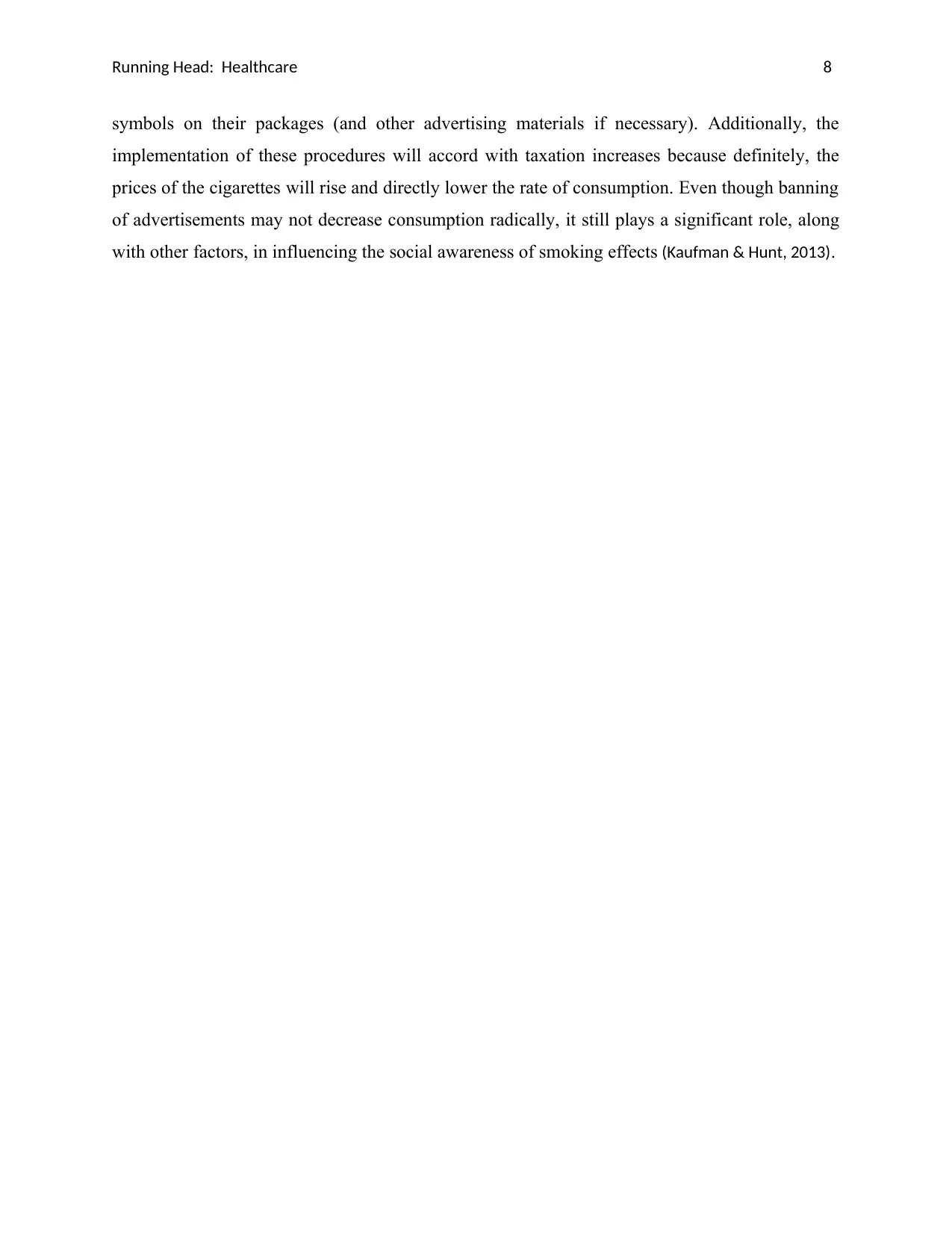
Running Head: Healthcare 8
symbols on their packages (and other advertising materials if necessary). Additionally, the
implementation of these procedures will accord with taxation increases because definitely, the
prices of the cigarettes will rise and directly lower the rate of consumption. Even though banning
of advertisements may not decrease consumption radically, it still plays a significant role, along
with other factors, in influencing the social awareness of smoking effects (Kaufman & Hunt, 2013).
symbols on their packages (and other advertising materials if necessary). Additionally, the
implementation of these procedures will accord with taxation increases because definitely, the
prices of the cigarettes will rise and directly lower the rate of consumption. Even though banning
of advertisements may not decrease consumption radically, it still plays a significant role, along
with other factors, in influencing the social awareness of smoking effects (Kaufman & Hunt, 2013).
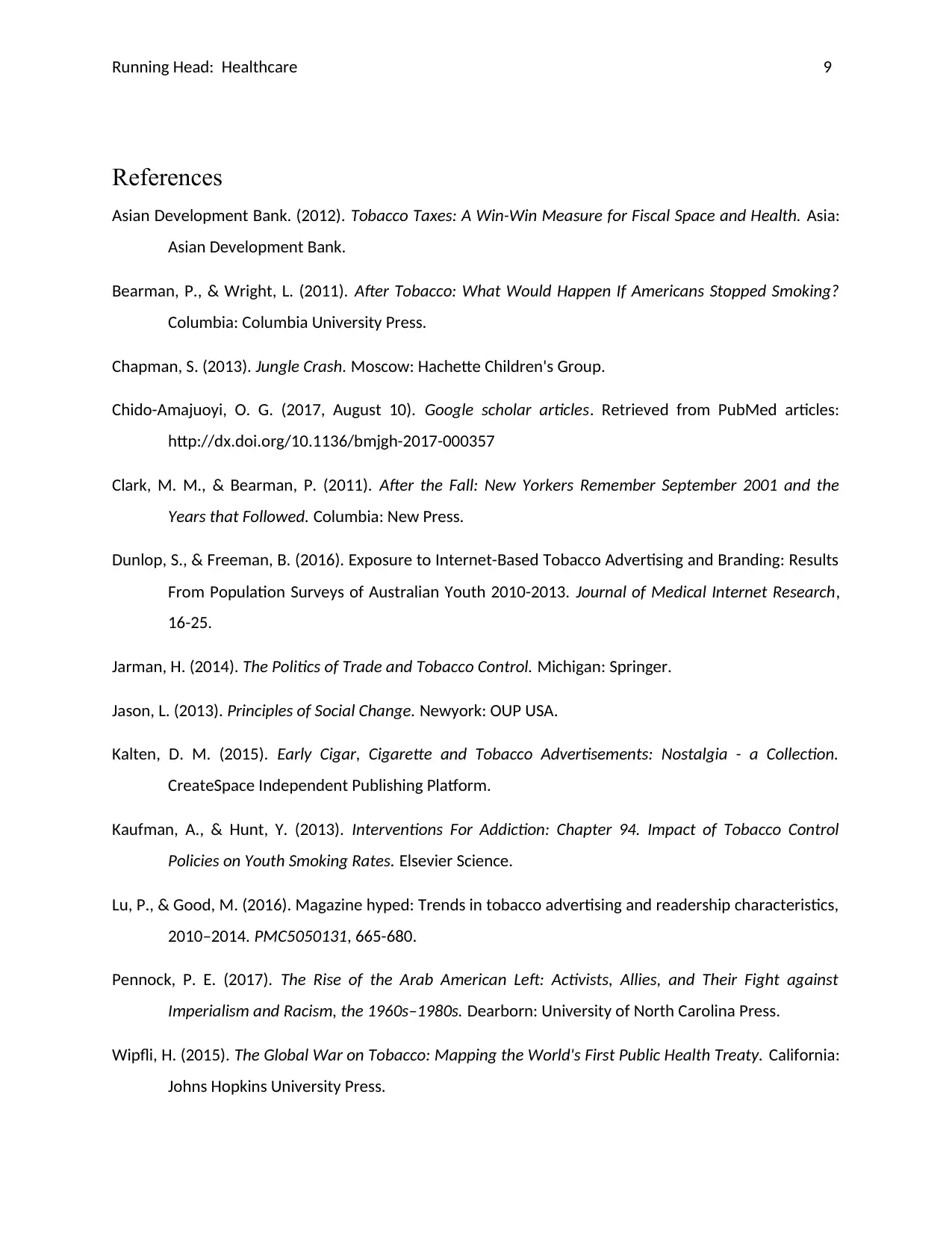
Running Head: Healthcare 9
References
Asian Development Bank. (2012). Tobacco Taxes: A Win-Win Measure for Fiscal Space and Health. Asia:
Asian Development Bank.
Bearman, P., & Wright, L. (2011). After Tobacco: What Would Happen If Americans Stopped Smoking?
Columbia: Columbia University Press.
Chapman, S. (2013). Jungle Crash. Moscow: Hachette Children's Group.
Chido-Amajuoyi, O. G. (2017, August 10). Google scholar articles. Retrieved from PubMed articles:
http://dx.doi.org/10.1136/bmjgh-2017-000357
Clark, M. M., & Bearman, P. (2011). After the Fall: New Yorkers Remember September 2001 and the
Years that Followed. Columbia: New Press.
Dunlop, S., & Freeman, B. (2016). Exposure to Internet-Based Tobacco Advertising and Branding: Results
From Population Surveys of Australian Youth 2010-2013. Journal of Medical Internet Research,
16-25.
Jarman, H. (2014). The Politics of Trade and Tobacco Control. Michigan: Springer.
Jason, L. (2013). Principles of Social Change. Newyork: OUP USA.
Kalten, D. M. (2015). Early Cigar, Cigarette and Tobacco Advertisements: Nostalgia - a Collection.
CreateSpace Independent Publishing Platform.
Kaufman, A., & Hunt, Y. (2013). Interventions For Addiction: Chapter 94. Impact of Tobacco Control
Policies on Youth Smoking Rates. Elsevier Science.
Lu, P., & Good, M. (2016). Magazine hyped: Trends in tobacco advertising and readership characteristics,
2010–2014. PMC5050131, 665-680.
Pennock, P. E. (2017). The Rise of the Arab American Left: Activists, Allies, and Their Fight against
Imperialism and Racism, the 1960s–1980s. Dearborn: University of North Carolina Press.
Wipfli, H. (2015). The Global War on Tobacco: Mapping the World's First Public Health Treaty. California:
Johns Hopkins University Press.
References
Asian Development Bank. (2012). Tobacco Taxes: A Win-Win Measure for Fiscal Space and Health. Asia:
Asian Development Bank.
Bearman, P., & Wright, L. (2011). After Tobacco: What Would Happen If Americans Stopped Smoking?
Columbia: Columbia University Press.
Chapman, S. (2013). Jungle Crash. Moscow: Hachette Children's Group.
Chido-Amajuoyi, O. G. (2017, August 10). Google scholar articles. Retrieved from PubMed articles:
http://dx.doi.org/10.1136/bmjgh-2017-000357
Clark, M. M., & Bearman, P. (2011). After the Fall: New Yorkers Remember September 2001 and the
Years that Followed. Columbia: New Press.
Dunlop, S., & Freeman, B. (2016). Exposure to Internet-Based Tobacco Advertising and Branding: Results
From Population Surveys of Australian Youth 2010-2013. Journal of Medical Internet Research,
16-25.
Jarman, H. (2014). The Politics of Trade and Tobacco Control. Michigan: Springer.
Jason, L. (2013). Principles of Social Change. Newyork: OUP USA.
Kalten, D. M. (2015). Early Cigar, Cigarette and Tobacco Advertisements: Nostalgia - a Collection.
CreateSpace Independent Publishing Platform.
Kaufman, A., & Hunt, Y. (2013). Interventions For Addiction: Chapter 94. Impact of Tobacco Control
Policies on Youth Smoking Rates. Elsevier Science.
Lu, P., & Good, M. (2016). Magazine hyped: Trends in tobacco advertising and readership characteristics,
2010–2014. PMC5050131, 665-680.
Pennock, P. E. (2017). The Rise of the Arab American Left: Activists, Allies, and Their Fight against
Imperialism and Racism, the 1960s–1980s. Dearborn: University of North Carolina Press.
Wipfli, H. (2015). The Global War on Tobacco: Mapping the World's First Public Health Treaty. California:
Johns Hopkins University Press.
⊘ This is a preview!⊘
Do you want full access?
Subscribe today to unlock all pages.

Trusted by 1+ million students worldwide
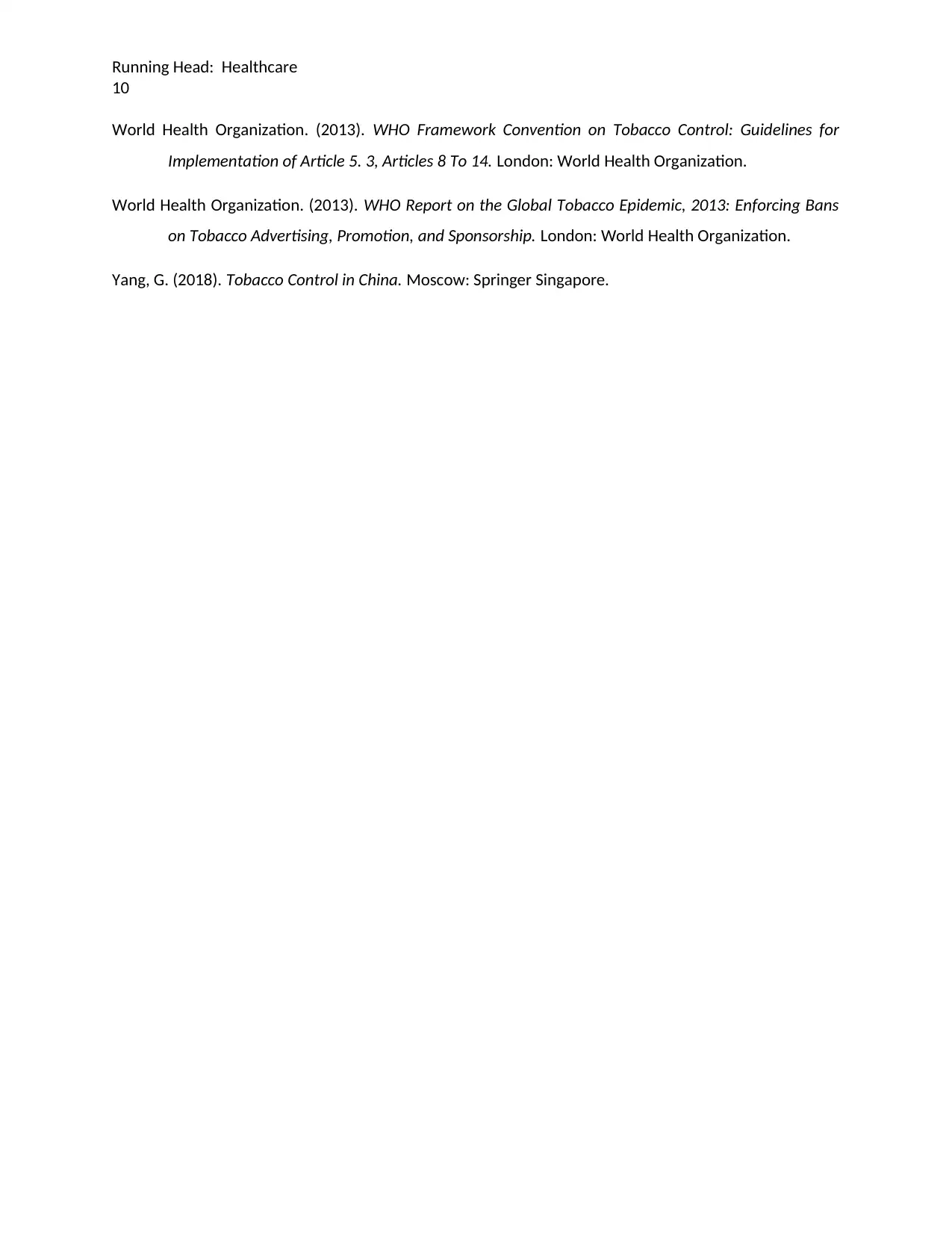
Running Head: Healthcare
10
World Health Organization. (2013). WHO Framework Convention on Tobacco Control: Guidelines for
Implementation of Article 5. 3, Articles 8 To 14. London: World Health Organization.
World Health Organization. (2013). WHO Report on the Global Tobacco Epidemic, 2013: Enforcing Bans
on Tobacco Advertising, Promotion, and Sponsorship. London: World Health Organization.
Yang, G. (2018). Tobacco Control in China. Moscow: Springer Singapore.
10
World Health Organization. (2013). WHO Framework Convention on Tobacco Control: Guidelines for
Implementation of Article 5. 3, Articles 8 To 14. London: World Health Organization.
World Health Organization. (2013). WHO Report on the Global Tobacco Epidemic, 2013: Enforcing Bans
on Tobacco Advertising, Promotion, and Sponsorship. London: World Health Organization.
Yang, G. (2018). Tobacco Control in China. Moscow: Springer Singapore.
1 out of 10
Related Documents
Your All-in-One AI-Powered Toolkit for Academic Success.
+13062052269
info@desklib.com
Available 24*7 on WhatsApp / Email
![[object Object]](/_next/static/media/star-bottom.7253800d.svg)
Unlock your academic potential
Copyright © 2020–2025 A2Z Services. All Rights Reserved. Developed and managed by ZUCOL.





